Cast It Again for Its Mana Cost Mtg
| Transform | |
|---|---|
| Last Used: | Eldritch Moon |
| Introduced: | Innistrad |
| | |
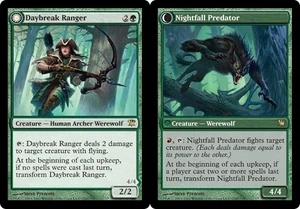
Daybreak Ranger, an example of a card that transforms.
Transform is a keyword action.
Details
Transform is a mechanic introduced in Innistrad, the first set of the Innistrad Block. It appears on certain cards that are hard to explain, so let's get onto that
Innistrad is a horror set. Vampires, werewolves, zombies, and ghosts are all included as main horror creature types. Werewolves are creatures that are supposed be humans at daytime, and werewolves at nighttime. For the first time in Magic history, double-faced cards have been printed. A double-faced card doesn't have a normal Magic: The Gathering back side. Instead, it has another card! Take Grizzled Outcasts as an example. When you just look at it, you can see that it's a five-mana 4/4. No big deal. But Grizzled Outcasts has an ability, transform. It says...
"At the beginning of each upkeep, if no spells were cast last turn, transform Grizzled Outcasts."
That means that at the beginning of every upkeep, Grizzled Outcasts checks the last turn to see how many spells were cast during it. If there weren't any spells cast on that turn, it transforms. Transform means that you turn the card around, so the back side is face up. The new side has several features. There's no converted mana cost, because you already cast the card. The new side is no longer called Grizzled Outcasts, but instead it's called Krallenhorde Wantons. It's still a werewolf, but it's not a human anymore. It also isn't a 4/4 anymore. It's a 7/7! Also, the text is different. Grizzled Outcasts says no spells. Krallenhorde Wantons says two spells! So Krallenhorde Wantons, at the beginning of each upkeep, checks last turn at sees how many spells were cast. If two or more were cast, it transforms again and turns back into Grizzled Outcasts.
Grizzled Outcasts is a werewolf. There are lots of werewolves in Innistrad, split into red and green. However, it's boring if all the transform cards are only in red and green. Therefore, there are transform cards in every color, they're just not werewolves. Look at Civilized Scholar as an example. It doesn't have the werewolf text that Grizzled Outcasts has. Instead, it transforms when you use its Merfolk Looter-type ability. It also doesn't just transform, you also get to untap it! It transforms into a 5/1 with no abilities, but since you untap it, you get to smash with it right away. If you don't attack, then you just tap it and it turns back into Civilized Scholar. The back side, is called Homicidal Brute. But since blue doesn't have 5/1's, the back side is actually a red card! There is only one other card in Innistrad that transforms into a different color.
Outside werewolves, there are lots of ways for transform cards to transform. Bloodline Keeper allows you to transform whenever you want, as long as you pay one black mana and you have at least five vampires, including itself.
Transform cards have some other features that other cards don't have. They have a sun next to their name on the front side, and a moon on the back side. The back side has circle next to the card type that shows what color it is. On the front side, you can see some numbers above the power/toughness box. They show the power and toughness of the other side of the card.
Most transform cards are creatures, but there's one that's not. It's called Garruk Relentless, and he's a planeswalker! He transforms when he has two or fewer loyalty counters. Garruk transforms into a black and green card. His moon side doesn't have a loyalty box, because you should already know what the loyalty is. If you transform Garruk, you can't use one of the his moon abilities until your next turn. Garruk, like some transform cards, can't turn back into Garruk Relentless once he becomes Garruk, the Veil Cursed. there are some others in Dark Ascension like Elbrus or Soul Seizer.
That's about it for the keyword transform. Check out Innistrad's other mechanics and keywords!
Comprehensive Rules
- 711.Double-Faced Cards
-
- 711.1. A double-faced card has a Magic card face on each side rather than a Magic card face on one side and a Magic card back on the other. Each face may have abilities that allow the card to "transform," or turn over to its other face. Tokens and cards with a Magic card back can't transform. (See rule 701.25, "Transform.")
-
- 711.1a A double-faced card's front face is marked by a front-face symbol in its upper left corner. On cards in the Innistrad block and Shadows over Innistrad set, the front-face symbol is a sun. On Magic Origins double-faced cards, the front-face symbol is a modified Planeswalker icon.
- 711.1b A double-faced card's back face is marked by a back-face symbol in its upper left corner. On cards in the Innistrad block and Shadows over Innistrad set, the back-face symbol is a crescent moon. On Magic Origins double-faced cards, the back-face symbol is a full Planeswalker icon.
- 711.1c If the back face of a double-faced card is a creature, the front face of that card will have the back face's power and toughness printed in gray above the power and toughness box. This is reminder text and has no effect on game play.
- 711.2. Players who are allowed to look at a double-faced card may look at both faces.
- 711.3. Players must ensure that double-faced cards in hidden zones are indistinguishable from other cards in the same zone. To do this, the owner of a double-faced card may use completely opaque card sleeves or substitute a checklist card. Sanctioned tournaments have additional rules for playing with double-faced cards. See rule 100.6.
-
- 711.3a A checklist card has a normal Magic card back. The face of a checklist card is divided into sections. Each section lists the name and mana cost of each double-faced card it could represent and includes a fill-in circle. Before a checklist card can be used, exactly one of the fill-in circles must be marked to denote which double-faced card the checklist card represents.
- 711.3b If a checklist card is used in a deck, the double-faced card it represents is set aside prior to the beginning of the game (see rule 103.1a) and must remain available throughout the game. A checklist card can't be included in a deck unless it is representing a double-faced card.
- 711.3c For all game purposes, the checklist card is considered to be the double-faced card it's representing.
- 711.3d If the checklist card is face up in a public zone, it should be set aside and the double-faced card used instead.
- 711.4. Each face of a double-faced card has its own set of characteristics.
-
- 711.4a While a double-faced card is outside the game, in a zone other than the battlefield, or on the battlefield with its front face up, it has only the characteristics of its front face.
- 711.4b While a double-faced permanent's back face is up, it has only the characteristics of its back face. However, its converted mana cost is calculated using the mana cost of its front face. This is a change from previous rules. If a permanent is copying the back face of a double-faced card (even if the card representing that copy is itself a double-faced card), the converted mana cost of that permanent is 0.
- 711.5. Only permanents represented by double-faced cards can transform. (See rule 701.25, "Transform.") If a spell or ability instructs a player to transform any permanent that isn't represented by a double-faced card, nothing happens.
-
-
-
- Example: A Clone enters the battlefield as a copy of Wildblood Pack (the back face of a double-faced card). The Clone will be a copy of the Wildblood Pack. Because the Clone is itself not a double-faced card, it can't transform.
- Example: A player casts Cytoshape, causing a Kruin Outlaw (the front face of a double-faced card) to become a copy of Elite Vanguard (a 2/1 Human Soldier creature) until end of turn. The player then casts Moonmist, which reads, in part, "Transform all Humans." Because the copy of Elite Vanguard is a double-faced card, it will transform. The resulting permanent will have its back face up, but it will still be a copy of Elite Vanguard that turn.
-
-
- 711.6. If a spell or ability instructs a player to transform a permanent, and the face that permanent would transform into is represented by an instant or sorcery card face, nothing happens.
- 711.7. If a double-faced card is cast as a spell, it's put on the stack with its front face up. See rule 601, "Casting Spells."
- 711.8. A double-faced card enters the battlefield with its front face up by default. If a spell or ability puts it onto the battlefield "transformed," it enters the battlefield with its back face up.
-
- 711.8a If a player is instructed to put a card that isn't a double-faced card onto the battlefield transformed, that card stays in its current zone. This is a change from previous rules.
- 711.9. If an effect allows a player to cast a double-faced card as a face-down creature spell, or if a double-faced card enters the battlefield face down, it will have the characteristics given to it by the rule or effect that caused it to be face down. That card remains hidden, using either a face-down checklist card or opaque sleeves. See rule 707, "Face-Down Spells and Permanents."
-
- 711.9a While face down, a double-faced permanent can't transform. If it is turned face up, it will have its front face up.
- 711.10. Double-faced permanents can't be turned face down. If a spell or ability tries to turn a double-faced permanent face down, nothing happens.
- 711.11. A double-faced card that is exiled face down remains hidden, using either a face-down checklist card or opaque sleeves. See rule 711.3.
- 711.12. When a double-faced permanent transforms, it doesn't become a new object. Any effects that applied to that permanent will continue to apply to it after it transforms.
-
-
-
- Example: An effect gives Village Ironsmith (the front face of a double-faced card) +2/+2 until end of turn and then Village Ironsmith transforms into Ironfang. Ironfang will continue to get +2/+2 until end of turn.
-
-
- 711.13. If an effect instructs a player to name a card, the player may name either face of a double-faced card but not both.
-
Gallery
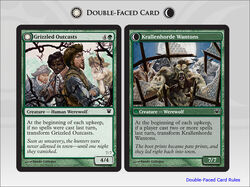
Grizzled Outcasts
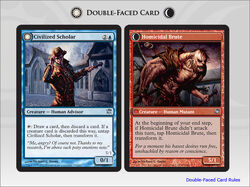
Civilized Scholar
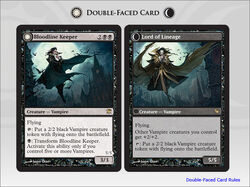
Bloodline Keeper
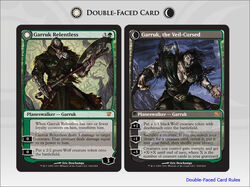
Garruk Relentless
| Keyword Actions | ||
|---|---|---|
| Evergreen | Activate • Attach • Cast • Counter • Destroy • Discard Exchange • Exile • Fight • Play • Regenerate • Reveal Sacrifice • Scry • Search • Shuffle • Tap • Untap | |
| Other | Abandon • Bolster • Clash • Detain • Fateseal • Investigate Manifest • Monstrosity • Planeswalk • Populate • Proliferate Set in Motion • Support • Transform • Vote | |
Source: https://mtg-archive.fandom.com/wiki/Transform
0 Response to "Cast It Again for Its Mana Cost Mtg"
Postar um comentário